Psychometric Analysis Report: A Case Study of AIDA, Abu Dhabi
VerifiedAdded on 2020/04/01
|7
|1332
|52
Report
AI Summary
This report presents a case study of the Abu Dhabi Investment Authority (AIDA), focusing on the application and effectiveness of psychometric assessment tests. The research aims to analyze these tests to understand their impact on employee training needs and overall organizational efficiency. The study employs a positivist research philosophy and a deductive approach, utilizing questionnaires and statistical data analysis to assess the behavioral patterns of employees and board members. The report details the test design, sample selection, and equipment used, including questionnaires designed to evaluate employee behavior in various scenarios. The analysis focuses on quantitative methods to derive measurable results, with the goal of determining the tests' ability to predict employee behavior and inform training strategies. The hypothesis explores whether these assessments have positive or negative effects on employees, with the ultimate aim of optimizing recruitment, employee retention, and skill development within AIDA. The report provides a comprehensive overview of the psychometric assessment process and its implications for organizational success.
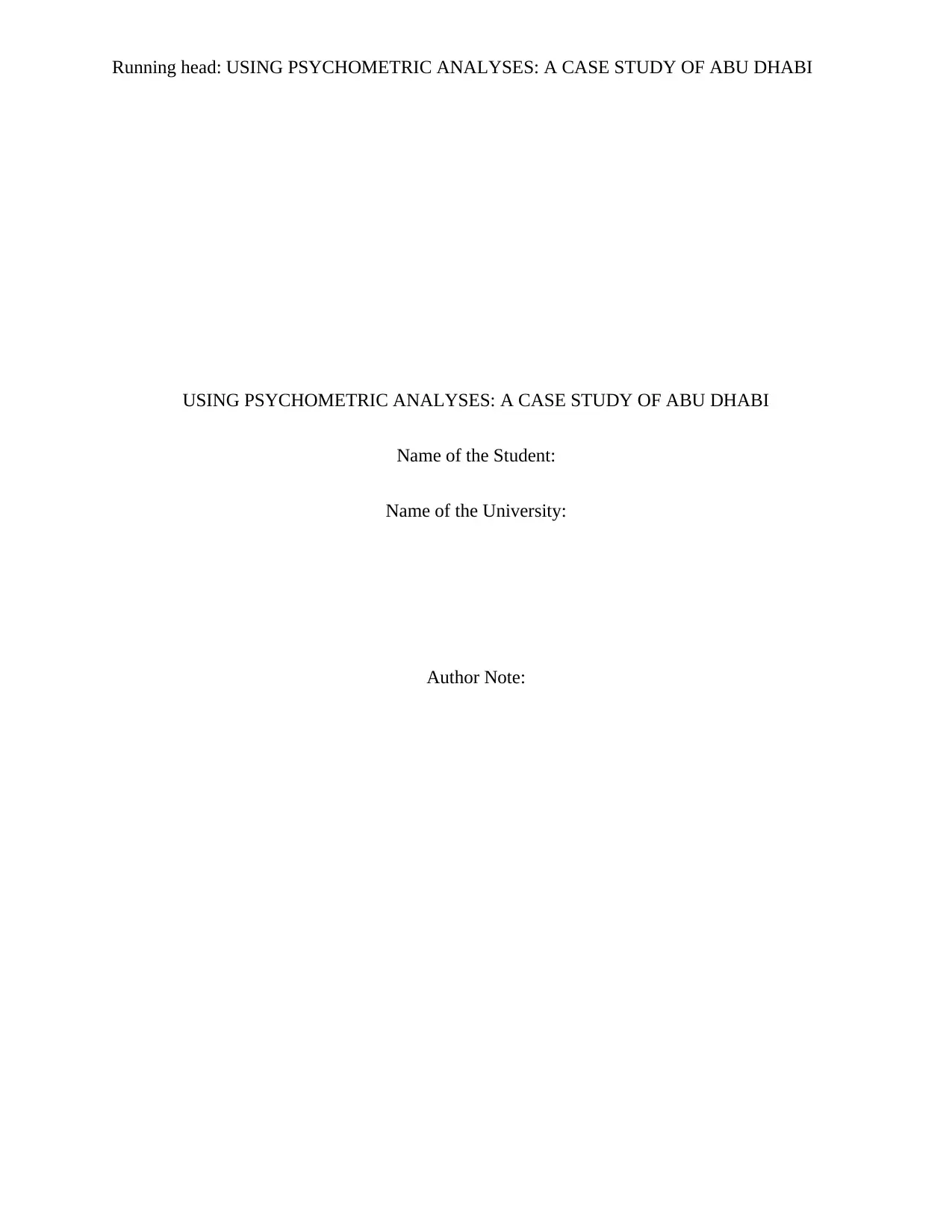
Running head: USING PSYCHOMETRIC ANALYSES: A CASE STUDY OF ABU DHABI
USING PSYCHOMETRIC ANALYSES: A CASE STUDY OF ABU DHABI
Name of the Student:
Name of the University:
Author Note:
USING PSYCHOMETRIC ANALYSES: A CASE STUDY OF ABU DHABI
Name of the Student:
Name of the University:
Author Note:
Paraphrase This Document
Need a fresh take? Get an instant paraphrase of this document with our AI Paraphraser
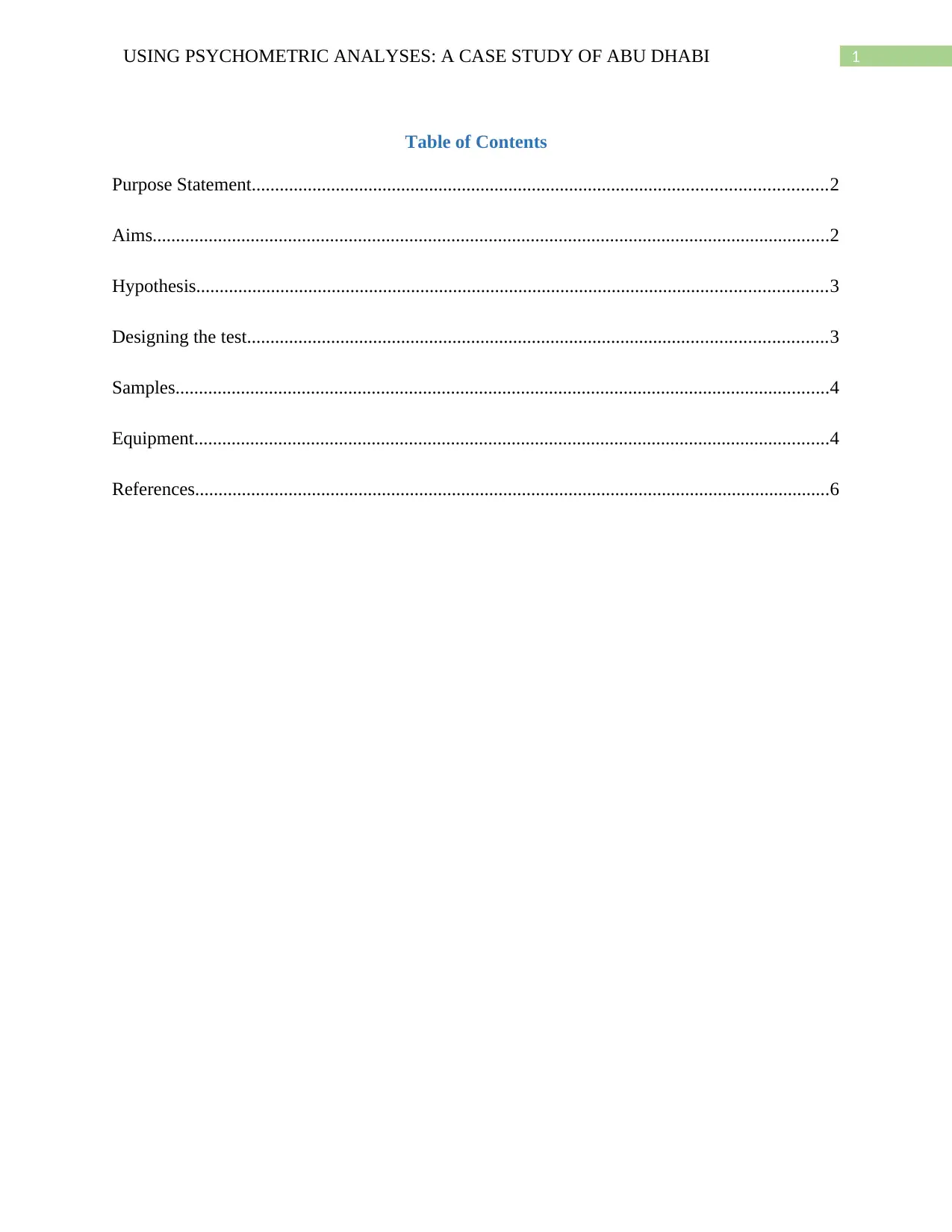
1USING PSYCHOMETRIC ANALYSES: A CASE STUDY OF ABU DHABI
Table of Contents
Purpose Statement...........................................................................................................................2
Aims.................................................................................................................................................2
Hypothesis.......................................................................................................................................3
Designing the test............................................................................................................................3
Samples............................................................................................................................................4
Equipment........................................................................................................................................4
References........................................................................................................................................6
Table of Contents
Purpose Statement...........................................................................................................................2
Aims.................................................................................................................................................2
Hypothesis.......................................................................................................................................3
Designing the test............................................................................................................................3
Samples............................................................................................................................................4
Equipment........................................................................................................................................4
References........................................................................................................................................6
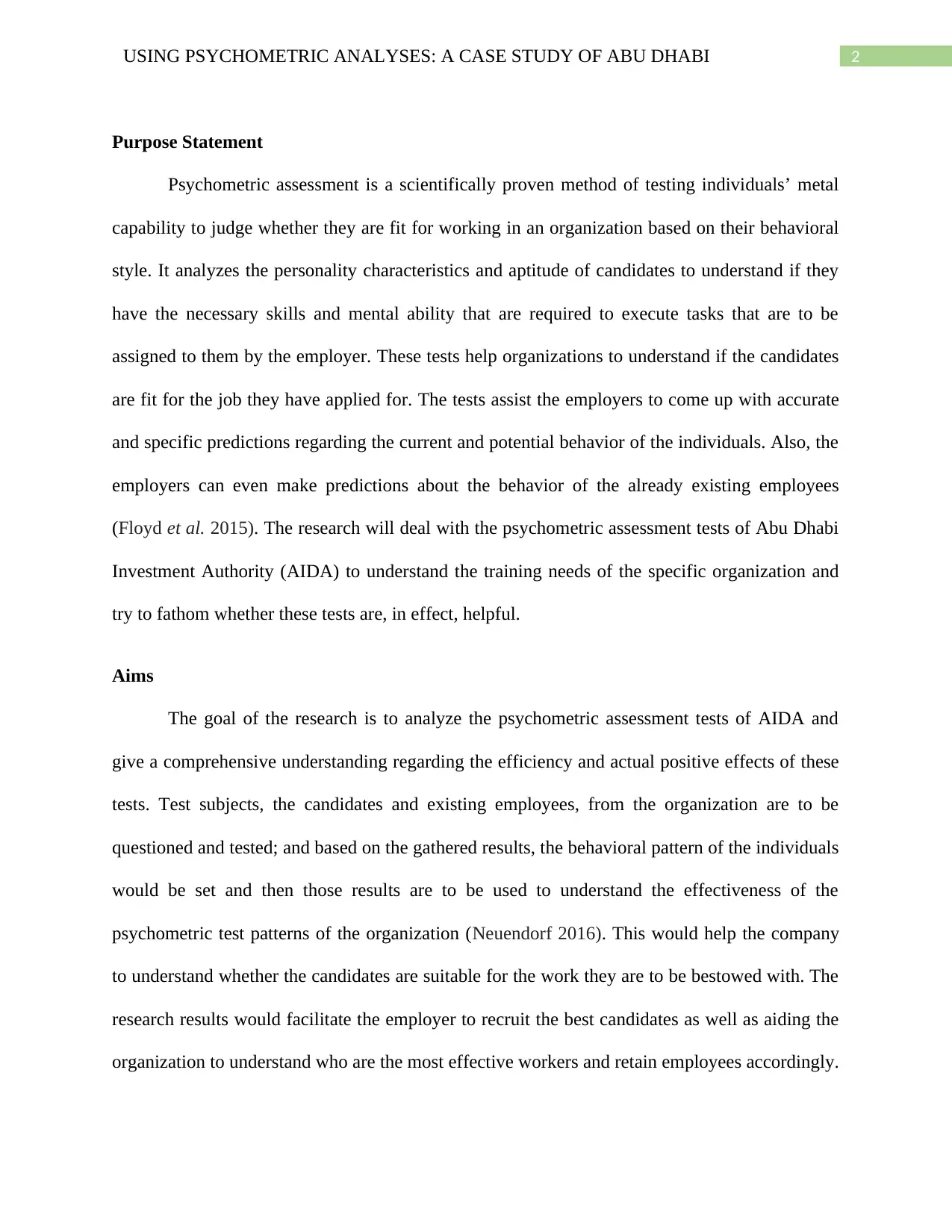
2USING PSYCHOMETRIC ANALYSES: A CASE STUDY OF ABU DHABI
Purpose Statement
Psychometric assessment is a scientifically proven method of testing individuals’ metal
capability to judge whether they are fit for working in an organization based on their behavioral
style. It analyzes the personality characteristics and aptitude of candidates to understand if they
have the necessary skills and mental ability that are required to execute tasks that are to be
assigned to them by the employer. These tests help organizations to understand if the candidates
are fit for the job they have applied for. The tests assist the employers to come up with accurate
and specific predictions regarding the current and potential behavior of the individuals. Also, the
employers can even make predictions about the behavior of the already existing employees
(Floyd et al. 2015). The research will deal with the psychometric assessment tests of Abu Dhabi
Investment Authority (AIDA) to understand the training needs of the specific organization and
try to fathom whether these tests are, in effect, helpful.
Aims
The goal of the research is to analyze the psychometric assessment tests of AIDA and
give a comprehensive understanding regarding the efficiency and actual positive effects of these
tests. Test subjects, the candidates and existing employees, from the organization are to be
questioned and tested; and based on the gathered results, the behavioral pattern of the individuals
would be set and then those results are to be used to understand the effectiveness of the
psychometric test patterns of the organization (Neuendorf 2016). This would help the company
to understand whether the candidates are suitable for the work they are to be bestowed with. The
research results would facilitate the employer to recruit the best candidates as well as aiding the
organization to understand who are the most effective workers and retain employees accordingly.
Purpose Statement
Psychometric assessment is a scientifically proven method of testing individuals’ metal
capability to judge whether they are fit for working in an organization based on their behavioral
style. It analyzes the personality characteristics and aptitude of candidates to understand if they
have the necessary skills and mental ability that are required to execute tasks that are to be
assigned to them by the employer. These tests help organizations to understand if the candidates
are fit for the job they have applied for. The tests assist the employers to come up with accurate
and specific predictions regarding the current and potential behavior of the individuals. Also, the
employers can even make predictions about the behavior of the already existing employees
(Floyd et al. 2015). The research will deal with the psychometric assessment tests of Abu Dhabi
Investment Authority (AIDA) to understand the training needs of the specific organization and
try to fathom whether these tests are, in effect, helpful.
Aims
The goal of the research is to analyze the psychometric assessment tests of AIDA and
give a comprehensive understanding regarding the efficiency and actual positive effects of these
tests. Test subjects, the candidates and existing employees, from the organization are to be
questioned and tested; and based on the gathered results, the behavioral pattern of the individuals
would be set and then those results are to be used to understand the effectiveness of the
psychometric test patterns of the organization (Neuendorf 2016). This would help the company
to understand whether the candidates are suitable for the work they are to be bestowed with. The
research results would facilitate the employer to recruit the best candidates as well as aiding the
organization to understand who are the most effective workers and retain employees accordingly.
⊘ This is a preview!⊘
Do you want full access?
Subscribe today to unlock all pages.

Trusted by 1+ million students worldwide
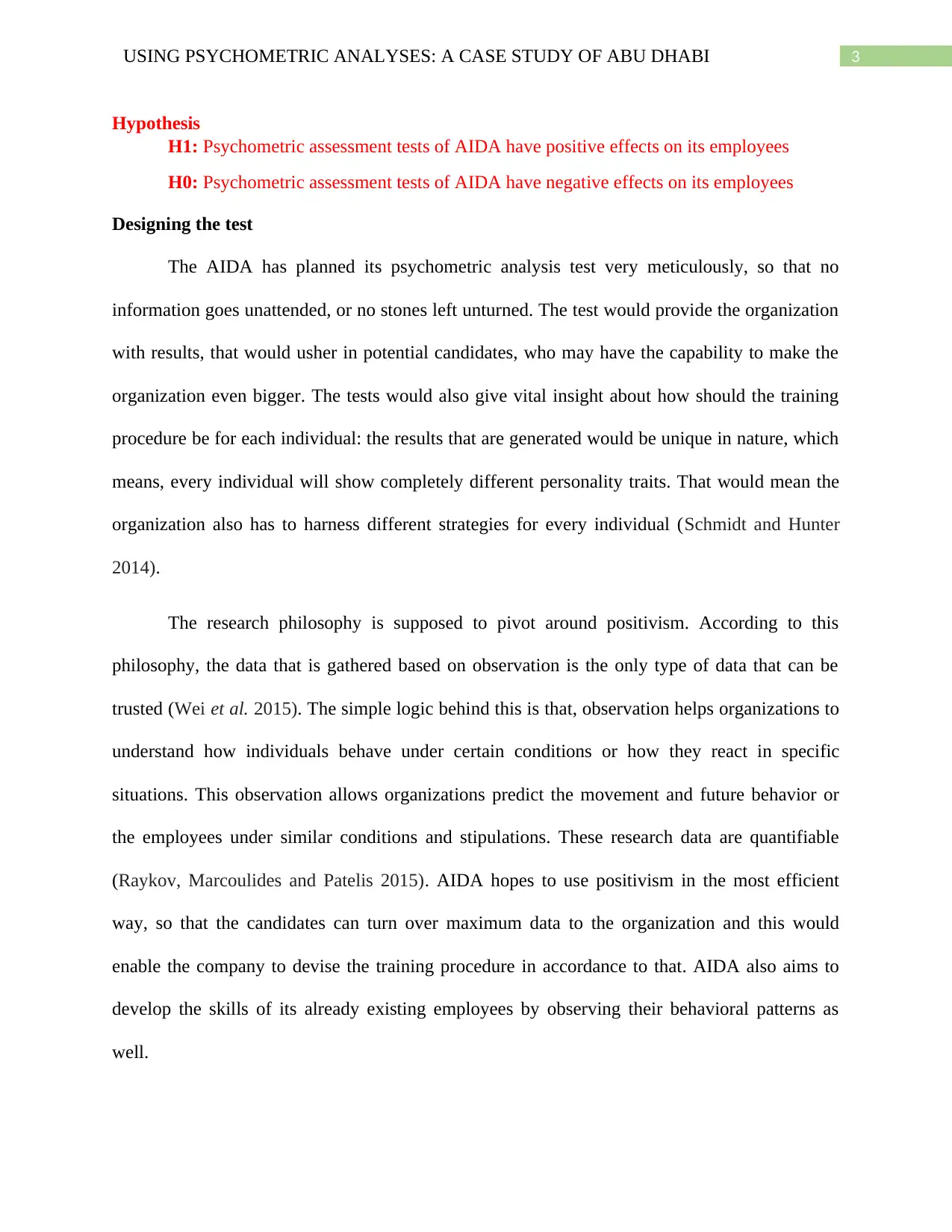
3USING PSYCHOMETRIC ANALYSES: A CASE STUDY OF ABU DHABI
Hypothesis
H1: Psychometric assessment tests of AIDA have positive effects on its employees
H0: Psychometric assessment tests of AIDA have negative effects on its employees
Designing the test
The AIDA has planned its psychometric analysis test very meticulously, so that no
information goes unattended, or no stones left unturned. The test would provide the organization
with results, that would usher in potential candidates, who may have the capability to make the
organization even bigger. The tests would also give vital insight about how should the training
procedure be for each individual: the results that are generated would be unique in nature, which
means, every individual will show completely different personality traits. That would mean the
organization also has to harness different strategies for every individual (Schmidt and Hunter
2014).
The research philosophy is supposed to pivot around positivism. According to this
philosophy, the data that is gathered based on observation is the only type of data that can be
trusted (Wei et al. 2015). The simple logic behind this is that, observation helps organizations to
understand how individuals behave under certain conditions or how they react in specific
situations. This observation allows organizations predict the movement and future behavior or
the employees under similar conditions and stipulations. These research data are quantifiable
(Raykov, Marcoulides and Patelis 2015). AIDA hopes to use positivism in the most efficient
way, so that the candidates can turn over maximum data to the organization and this would
enable the company to devise the training procedure in accordance to that. AIDA also aims to
develop the skills of its already existing employees by observing their behavioral patterns as
well.
Hypothesis
H1: Psychometric assessment tests of AIDA have positive effects on its employees
H0: Psychometric assessment tests of AIDA have negative effects on its employees
Designing the test
The AIDA has planned its psychometric analysis test very meticulously, so that no
information goes unattended, or no stones left unturned. The test would provide the organization
with results, that would usher in potential candidates, who may have the capability to make the
organization even bigger. The tests would also give vital insight about how should the training
procedure be for each individual: the results that are generated would be unique in nature, which
means, every individual will show completely different personality traits. That would mean the
organization also has to harness different strategies for every individual (Schmidt and Hunter
2014).
The research philosophy is supposed to pivot around positivism. According to this
philosophy, the data that is gathered based on observation is the only type of data that can be
trusted (Wei et al. 2015). The simple logic behind this is that, observation helps organizations to
understand how individuals behave under certain conditions or how they react in specific
situations. This observation allows organizations predict the movement and future behavior or
the employees under similar conditions and stipulations. These research data are quantifiable
(Raykov, Marcoulides and Patelis 2015). AIDA hopes to use positivism in the most efficient
way, so that the candidates can turn over maximum data to the organization and this would
enable the company to devise the training procedure in accordance to that. AIDA also aims to
develop the skills of its already existing employees by observing their behavioral patterns as
well.
Paraphrase This Document
Need a fresh take? Get an instant paraphrase of this document with our AI Paraphraser
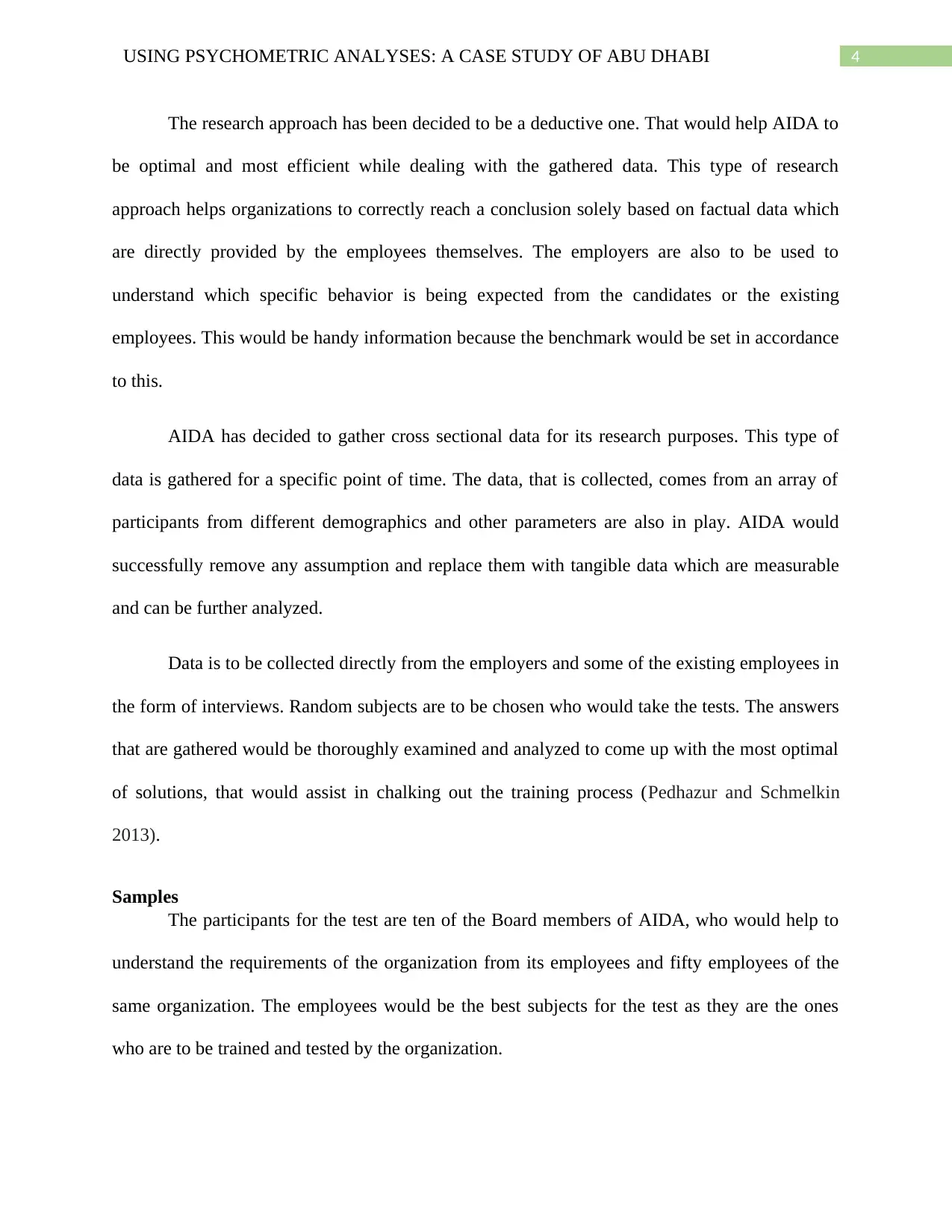
4USING PSYCHOMETRIC ANALYSES: A CASE STUDY OF ABU DHABI
The research approach has been decided to be a deductive one. That would help AIDA to
be optimal and most efficient while dealing with the gathered data. This type of research
approach helps organizations to correctly reach a conclusion solely based on factual data which
are directly provided by the employees themselves. The employers are also to be used to
understand which specific behavior is being expected from the candidates or the existing
employees. This would be handy information because the benchmark would be set in accordance
to this.
AIDA has decided to gather cross sectional data for its research purposes. This type of
data is gathered for a specific point of time. The data, that is collected, comes from an array of
participants from different demographics and other parameters are also in play. AIDA would
successfully remove any assumption and replace them with tangible data which are measurable
and can be further analyzed.
Data is to be collected directly from the employers and some of the existing employees in
the form of interviews. Random subjects are to be chosen who would take the tests. The answers
that are gathered would be thoroughly examined and analyzed to come up with the most optimal
of solutions, that would assist in chalking out the training process (Pedhazur and Schmelkin
2013).
Samples
The participants for the test are ten of the Board members of AIDA, who would help to
understand the requirements of the organization from its employees and fifty employees of the
same organization. The employees would be the best subjects for the test as they are the ones
who are to be trained and tested by the organization.
The research approach has been decided to be a deductive one. That would help AIDA to
be optimal and most efficient while dealing with the gathered data. This type of research
approach helps organizations to correctly reach a conclusion solely based on factual data which
are directly provided by the employees themselves. The employers are also to be used to
understand which specific behavior is being expected from the candidates or the existing
employees. This would be handy information because the benchmark would be set in accordance
to this.
AIDA has decided to gather cross sectional data for its research purposes. This type of
data is gathered for a specific point of time. The data, that is collected, comes from an array of
participants from different demographics and other parameters are also in play. AIDA would
successfully remove any assumption and replace them with tangible data which are measurable
and can be further analyzed.
Data is to be collected directly from the employers and some of the existing employees in
the form of interviews. Random subjects are to be chosen who would take the tests. The answers
that are gathered would be thoroughly examined and analyzed to come up with the most optimal
of solutions, that would assist in chalking out the training process (Pedhazur and Schmelkin
2013).
Samples
The participants for the test are ten of the Board members of AIDA, who would help to
understand the requirements of the organization from its employees and fifty employees of the
same organization. The employees would be the best subjects for the test as they are the ones
who are to be trained and tested by the organization.
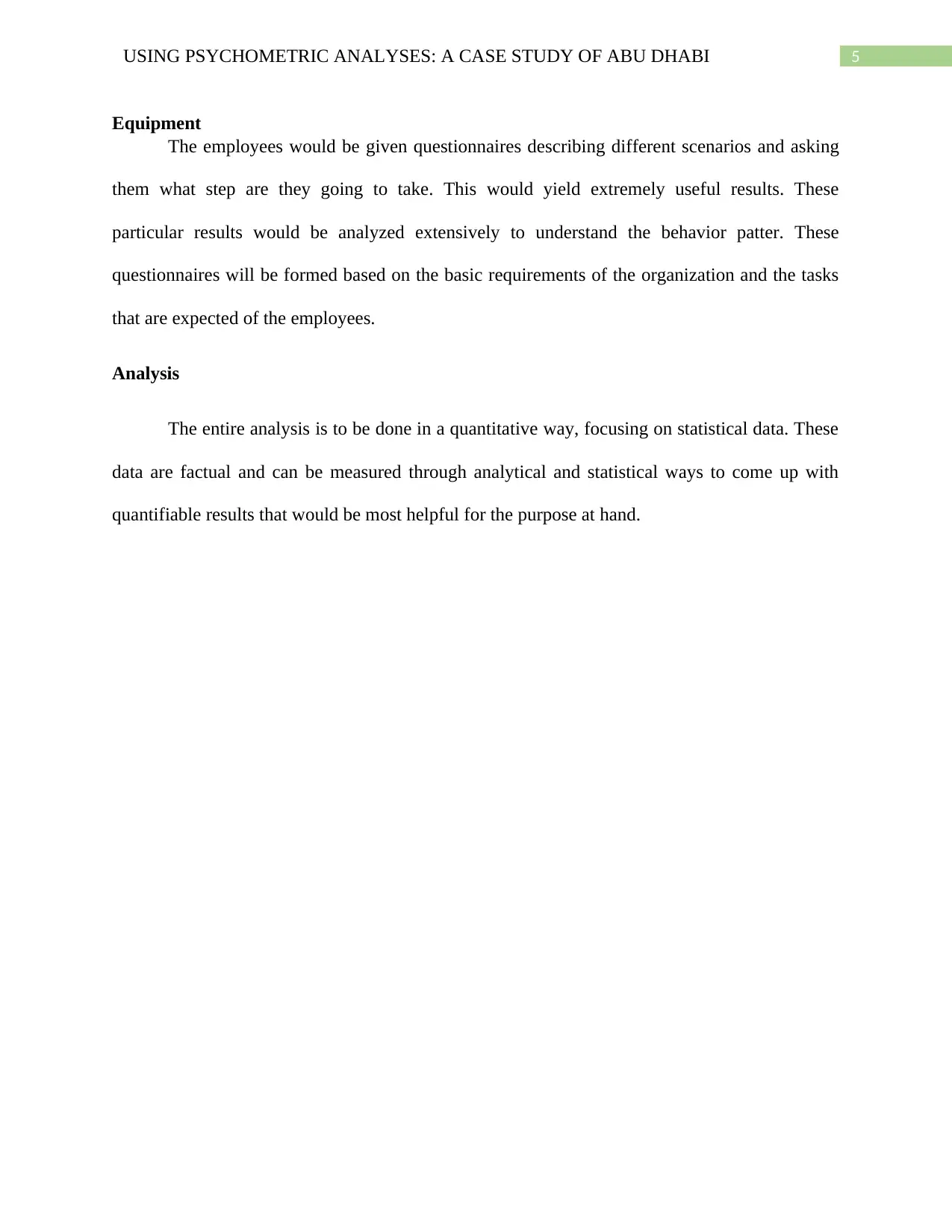
5USING PSYCHOMETRIC ANALYSES: A CASE STUDY OF ABU DHABI
Equipment
The employees would be given questionnaires describing different scenarios and asking
them what step are they going to take. This would yield extremely useful results. These
particular results would be analyzed extensively to understand the behavior patter. These
questionnaires will be formed based on the basic requirements of the organization and the tasks
that are expected of the employees.
Analysis
The entire analysis is to be done in a quantitative way, focusing on statistical data. These
data are factual and can be measured through analytical and statistical ways to come up with
quantifiable results that would be most helpful for the purpose at hand.
Equipment
The employees would be given questionnaires describing different scenarios and asking
them what step are they going to take. This would yield extremely useful results. These
particular results would be analyzed extensively to understand the behavior patter. These
questionnaires will be formed based on the basic requirements of the organization and the tasks
that are expected of the employees.
Analysis
The entire analysis is to be done in a quantitative way, focusing on statistical data. These
data are factual and can be measured through analytical and statistical ways to come up with
quantifiable results that would be most helpful for the purpose at hand.
⊘ This is a preview!⊘
Do you want full access?
Subscribe today to unlock all pages.

Trusted by 1+ million students worldwide
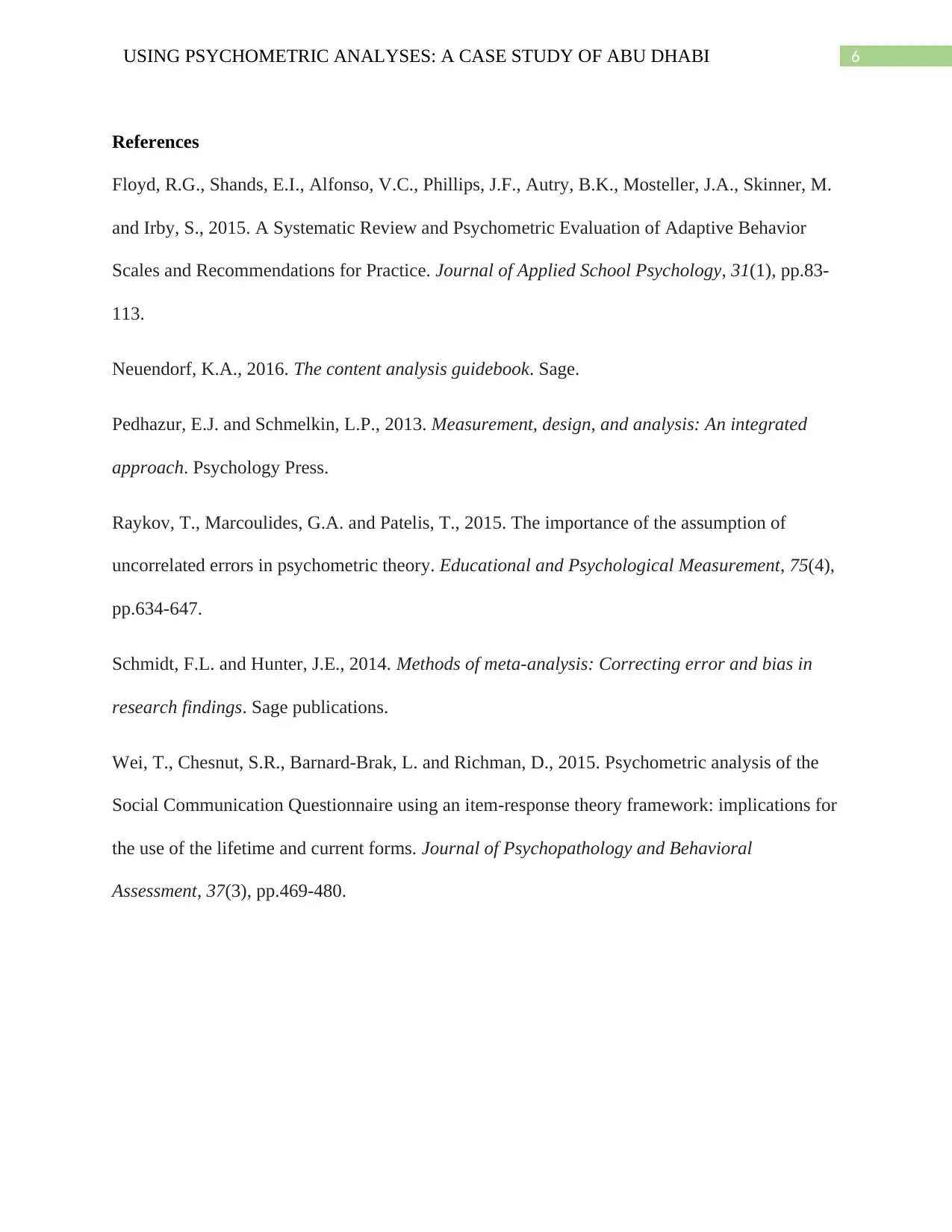
6USING PSYCHOMETRIC ANALYSES: A CASE STUDY OF ABU DHABI
References
Floyd, R.G., Shands, E.I., Alfonso, V.C., Phillips, J.F., Autry, B.K., Mosteller, J.A., Skinner, M.
and Irby, S., 2015. A Systematic Review and Psychometric Evaluation of Adaptive Behavior
Scales and Recommendations for Practice. Journal of Applied School Psychology, 31(1), pp.83-
113.
Neuendorf, K.A., 2016. The content analysis guidebook. Sage.
Pedhazur, E.J. and Schmelkin, L.P., 2013. Measurement, design, and analysis: An integrated
approach. Psychology Press.
Raykov, T., Marcoulides, G.A. and Patelis, T., 2015. The importance of the assumption of
uncorrelated errors in psychometric theory. Educational and Psychological Measurement, 75(4),
pp.634-647.
Schmidt, F.L. and Hunter, J.E., 2014. Methods of meta-analysis: Correcting error and bias in
research findings. Sage publications.
Wei, T., Chesnut, S.R., Barnard-Brak, L. and Richman, D., 2015. Psychometric analysis of the
Social Communication Questionnaire using an item-response theory framework: implications for
the use of the lifetime and current forms. Journal of Psychopathology and Behavioral
Assessment, 37(3), pp.469-480.
References
Floyd, R.G., Shands, E.I., Alfonso, V.C., Phillips, J.F., Autry, B.K., Mosteller, J.A., Skinner, M.
and Irby, S., 2015. A Systematic Review and Psychometric Evaluation of Adaptive Behavior
Scales and Recommendations for Practice. Journal of Applied School Psychology, 31(1), pp.83-
113.
Neuendorf, K.A., 2016. The content analysis guidebook. Sage.
Pedhazur, E.J. and Schmelkin, L.P., 2013. Measurement, design, and analysis: An integrated
approach. Psychology Press.
Raykov, T., Marcoulides, G.A. and Patelis, T., 2015. The importance of the assumption of
uncorrelated errors in psychometric theory. Educational and Psychological Measurement, 75(4),
pp.634-647.
Schmidt, F.L. and Hunter, J.E., 2014. Methods of meta-analysis: Correcting error and bias in
research findings. Sage publications.
Wei, T., Chesnut, S.R., Barnard-Brak, L. and Richman, D., 2015. Psychometric analysis of the
Social Communication Questionnaire using an item-response theory framework: implications for
the use of the lifetime and current forms. Journal of Psychopathology and Behavioral
Assessment, 37(3), pp.469-480.
1 out of 7
Related Documents
Your All-in-One AI-Powered Toolkit for Academic Success.
+13062052269
info@desklib.com
Available 24*7 on WhatsApp / Email
![[object Object]](/_next/static/media/star-bottom.7253800d.svg)
Unlock your academic potential
Copyright © 2020–2025 A2Z Services. All Rights Reserved. Developed and managed by ZUCOL.





